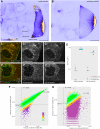Enzymatic production of single-molecule FISH and RNA capture probes
- PMID: 28698239
- PMCID: PMC5602115
- DOI: 10.1261/rna.061184.117
Enzymatic production of single-molecule FISH and RNA capture probes
Abstract
Arrays of singly labeled short oligonucleotides that hybridize to a specific target revolutionized RNA biology, enabling quantitative, single-molecule microscopy analysis and high-efficiency RNA/RNP capture. Here, we describe a simple and efficient method that allows flexible functionalization of inexpensive DNA oligonucleotides by different fluorescent dyes or biotin using terminal deoxynucleotidyl transferase and custom-made functional group conjugated dideoxy-UTP. We show that (i) all steps of the oligonucleotide labeling-including conjugation, enzymatic synthesis, and product purification-can be performed in a standard biology laboratory, (ii) the process yields >90%, often >95% labeled product with minimal carryover of impurities, and (iii) the oligonucleotides can be labeled with different dyes or biotin, allowing single-molecule FISH, RNA affinity purification, and Northern blot analysis to be performed.
Keywords: RNA affinity purification; dideoxy-UTP; oligonucleotide labeling; single-molecule FISH; terminal deoxynucleotidyl transferase.
© 2017 Gaspar et al.; Published by Cold Spring Harbor Laboratory Press for the RNA Society.
Figures




Similar articles
-
Analysis of oligonucleotide microarrays by 3' end labeling using fluorescent nucleotides and terminal transferase.Biotechniques. 2006 Jul;41(1):53-6. doi: 10.2144/000112182. Biotechniques. 2006. PMID: 16869513
-
Improved enzymatic labeling of fluorescent in situ hybridization probes applied to the visualization of retained introns in cells.RNA. 2023 Aug;29(8):1274-1287. doi: 10.1261/rna.079591.123. Epub 2023 May 2. RNA. 2023. PMID: 37130703 Free PMC article.
-
Combined in vitro transcription and reverse transcription to amplify and label complex synthetic oligonucleotide probe libraries.Biotechniques. 2015 Jun 1;58(6):301-7. doi: 10.2144/000114298. eCollection 2015 Jun. Biotechniques. 2015. PMID: 26054766 Free PMC article.
-
Enzymatic labeling of nucleic acids.Curr Protoc Immunol. 2001 May;Chapter 10:10.10.1-10.10.13. doi: 10.1002/0471142735.im1010s02. Curr Protoc Immunol. 2001. PMID: 18432673 Review.
-
Single-cell identification in microbial communities by improved fluorescence in situ hybridization techniques.Nat Rev Microbiol. 2008 May;6(5):339-48. doi: 10.1038/nrmicro1888. Nat Rev Microbiol. 2008. PMID: 18414500 Review.
Cited by
-
Single-molecule imaging reveals distinct elongation and frameshifting dynamics between frames of expanded RNA repeats in C9ORF72-ALS/FTD.Nat Commun. 2023 Sep 11;14(1):5581. doi: 10.1038/s41467-023-41339-x. Nat Commun. 2023. PMID: 37696852 Free PMC article.
-
Terminal Deoxynucleotidyl Transferase Mediated Production of Labeled Probes for Single-molecule FISH or RNA Capture.Bio Protoc. 2018 Mar 5;8(5):e2750. doi: 10.21769/BioProtoc.2750. eCollection 2018 Mar 5. Bio Protoc. 2018. PMID: 34179277 Free PMC article.
-
Molecular mechanisms of stress-induced reactivation in mumps virus condensates.Cell. 2023 Apr 27;186(9):1877-1894.e27. doi: 10.1016/j.cell.2023.03.015. Cell. 2023. PMID: 37116470 Free PMC article.
-
Isolation of mammalian stress granule cores for RNA-Seq analysis.Methods. 2018 Mar 15;137:49-54. doi: 10.1016/j.ymeth.2017.11.012. Epub 2017 Dec 1. Methods. 2018. PMID: 29196162 Free PMC article.
-
Hypoxic and pharmacological activation of HIF inhibits SARS-CoV-2 infection of lung epithelial cells.Cell Rep. 2021 Apr 20;35(3):109020. doi: 10.1016/j.celrep.2021.109020. Epub 2021 Apr 5. Cell Rep. 2021. PMID: 33852916 Free PMC article.
References
-
- Femino AM, Fay FS, Fogarty K, Singer RH. 1998. Visualization of single RNA transcripts in situ. Science 280: 585–590. - PubMed
Publication types
MeSH terms
Substances
LinkOut - more resources
Full Text Sources
Other Literature Sources
Molecular Biology Databases
